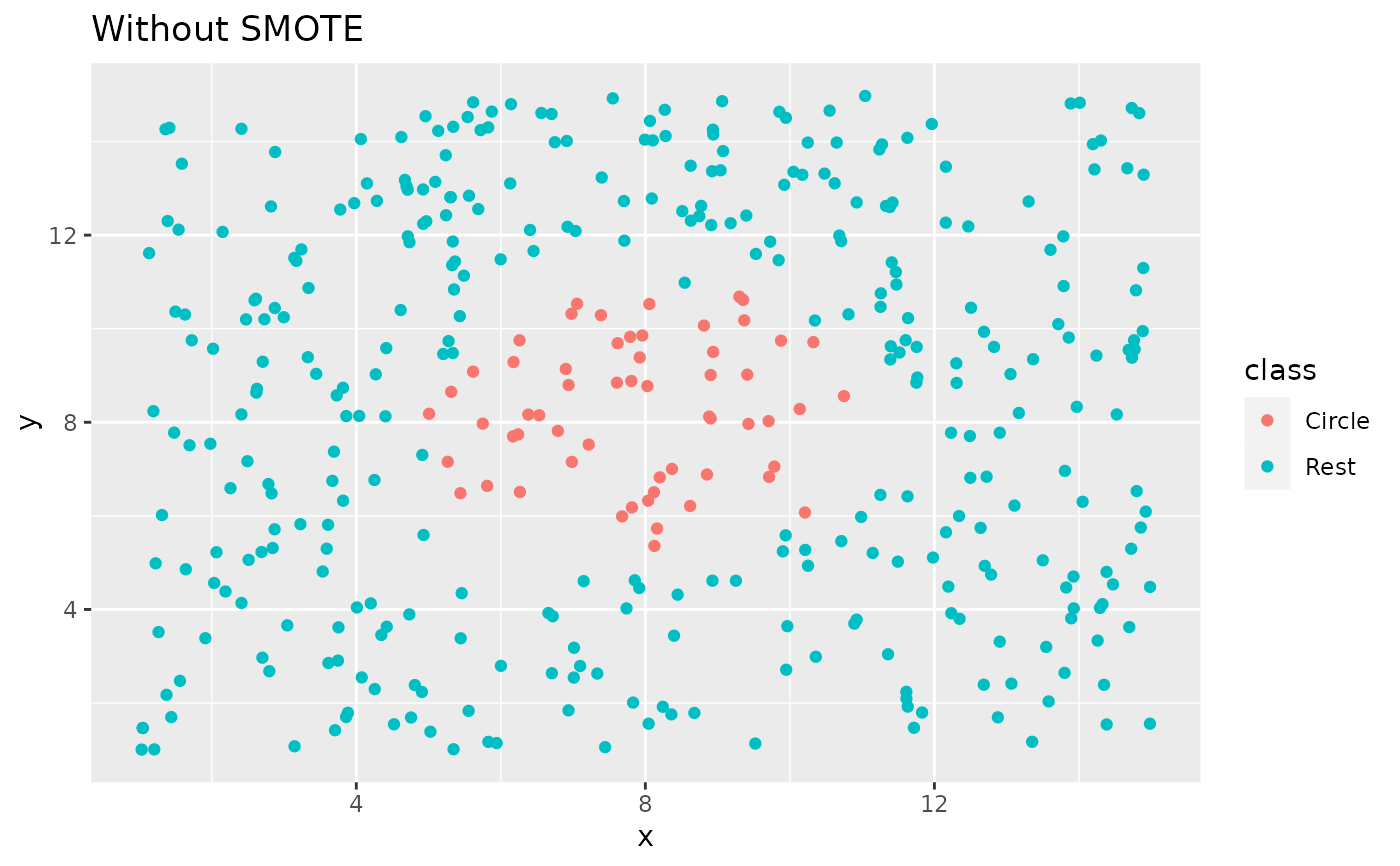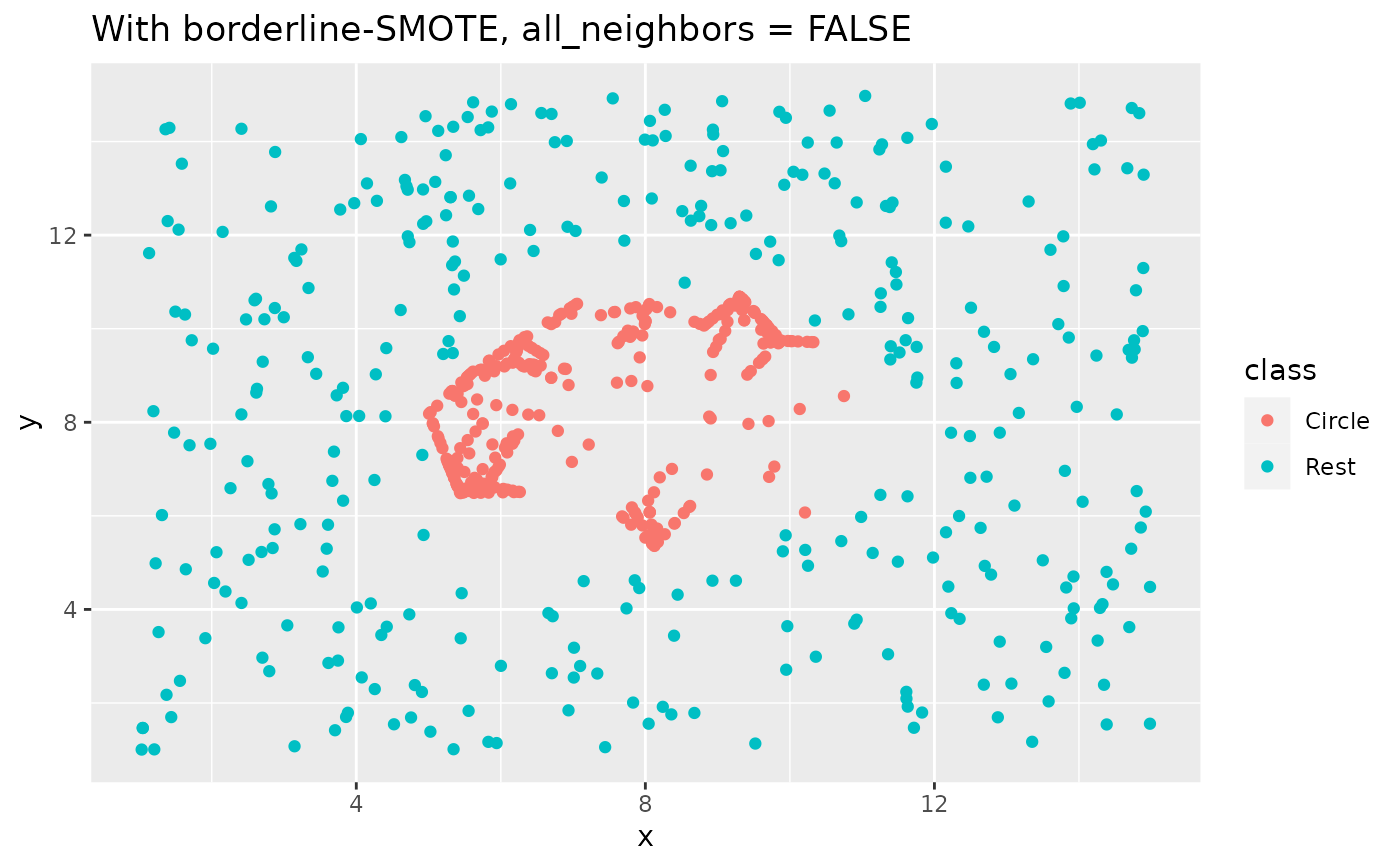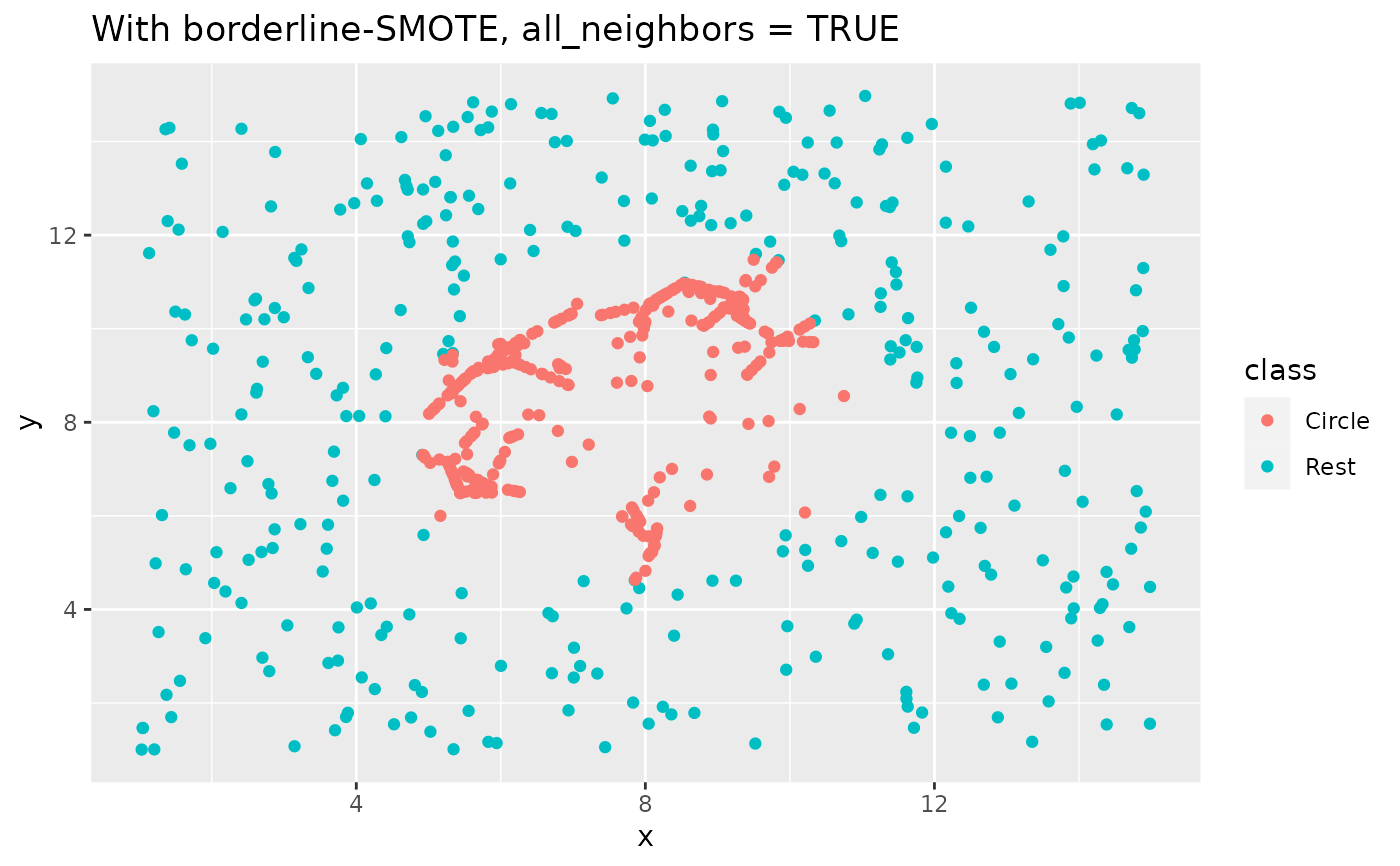step_bsmote() creates a specification of a recipe step that generate new
examples of the minority class using nearest neighbors of these cases in the
border region between classes.
Usage
step_bsmote(
recipe,
...,
role = NA,
trained = FALSE,
column = NULL,
over_ratio = 1,
neighbors = 5,
all_neighbors = FALSE,
skip = TRUE,
seed = sample.int(10^5, 1),
id = rand_id("bsmote")
)Arguments
- recipe
A recipe object. The step will be added to the sequence of operations for this recipe.
- ...
One or more selector functions to choose which variable is used to sample the data. See
selections()for more details. The selection should result in single factor variable. For thetidymethod, these are not currently used.- role
Not used by this step since no new variables are created.
- trained
A logical to indicate if the quantities for preprocessing have been estimated.
- column
A character string of the variable name that will be populated (eventually) by the
...selectors.- over_ratio
A numeric value for the ratio of the majority-to-minority frequencies. The default value (1) means that all other levels are sampled up to have the same frequency as the most occurring level. A value of 0.5 would mean that the minority levels will have (at most) (approximately) half as many rows than the majority level.
- neighbors
An integer. Number of nearest neighbor that are used to generate the new examples of the minority class.
- all_neighbors
Type of two borderline-SMOTE method. Defaults to FALSE. See details.
- skip
A logical. Should the step be skipped when the recipe is baked by
bake()? While all operations are baked whenprep()is run, some operations may not be able to be conducted on new data (e.g. processing the outcome variable(s)). Care should be taken when usingskip = TRUEas it may affect the computations for subsequent operations.- seed
An integer that will be used as the seed when smote-ing.
- id
A character string that is unique to this step to identify it.
Value
An updated version of recipe with the new step
added to the sequence of existing steps (if any). For the
tidy method, a tibble with columns terms which is
the variable used to sample.
Details
This methods works the same way as step_smote(), expect that instead of
generating points around every point of of the minority class each point is
first being classified into the boxes "danger" and "not". For each point the
k nearest neighbors is calculated. If all the neighbors comes from a
different class it is labeled noise and put in to the "not" box. If more then
half of the neighbors comes from a different class it is labeled "danger.
If all_neighbors = FALSE then points will be generated between nearest neighbors in its own class. If all_neighbors = TRUE then points will be generated between any nearest neighbors. See examples for visualization.
The parameter neighbors controls the way the new examples are created.
For each currently existing minority class example X new examples will be
created (this is controlled by the parameter over_ratio as mentioned
above). These examples will be generated by using the information from the
neighbors nearest neighbor of each example of the minority class.
The parameter neighbors controls how many of these neighbor are used.
All columns in the data are sampled and returned by juice()
and bake().
All columns used in this step must be numeric with no missing data.
When used in modeling, users should strongly consider using the
option skip = TRUE so that the extra sampling is not
conducted outside of the training set.
Tidying
When you tidy() this step, a tibble with columns terms
(the selectors or variables selected) will be returned.
Tuning Parameters
This step has 3 tuning parameters:
over_ratio: Over-Sampling Ratio (type: double, default: 1)neighbors: # Nearest Neighbors (type: integer, default: 5)all_neighbors: All Neighbors (type: logical, default: FALSE)
References
Hui Han, Wen-Yuan Wang, and Bing-Huan Mao. Borderline-smote: a new over-sampling method in imbalanced data sets learning. In International Conference on Intelligent Computing, pages 878–887. Springer, 2005.
See also
bsmote() for direct implementation
Other Steps for over-sampling:
step_adasyn(),
step_rose(),
step_smotenc(),
step_smote(),
step_upsample()
Examples
library(recipes)
library(modeldata)
data(hpc_data)
hpc_data0 <- hpc_data %>%
select(-protocol, -day)
orig <- count(hpc_data0, class, name = "orig")
orig
#> # A tibble: 4 × 2
#> class orig
#> <fct> <int>
#> 1 VF 2211
#> 2 F 1347
#> 3 M 514
#> 4 L 259
up_rec <- recipe(class ~ ., data = hpc_data0) %>%
# Bring the minority levels up to about 1000 each
# 1000/2211 is approx 0.4523
step_bsmote(class, over_ratio = 0.4523) %>%
prep()
training <- up_rec %>%
bake(new_data = NULL) %>%
count(class, name = "training")
training
#> # A tibble: 4 × 2
#> class training
#> <fct> <int>
#> 1 VF 2211
#> 2 F 1347
#> 3 M 1000
#> 4 L 1000
# Since `skip` defaults to TRUE, baking the step has no effect
baked <- up_rec %>%
bake(new_data = hpc_data0) %>%
count(class, name = "baked")
baked
#> # A tibble: 4 × 2
#> class baked
#> <fct> <int>
#> 1 VF 2211
#> 2 F 1347
#> 3 M 514
#> 4 L 259
# Note that if the original data contained more rows than the
# target n (= ratio * majority_n), the data are left alone:
orig %>%
left_join(training, by = "class") %>%
left_join(baked, by = "class")
#> # A tibble: 4 × 4
#> class orig training baked
#> <fct> <int> <int> <int>
#> 1 VF 2211 2211 2211
#> 2 F 1347 1347 1347
#> 3 M 514 1000 514
#> 4 L 259 1000 259
library(ggplot2)
ggplot(circle_example, aes(x, y, color = class)) +
geom_point() +
labs(title = "Without SMOTE")
 recipe(class ~ x + y, data = circle_example) %>%
step_bsmote(class, all_neighbors = FALSE) %>%
prep() %>%
bake(new_data = NULL) %>%
ggplot(aes(x, y, color = class)) +
geom_point() +
labs(title = "With borderline-SMOTE, all_neighbors = FALSE")
recipe(class ~ x + y, data = circle_example) %>%
step_bsmote(class, all_neighbors = FALSE) %>%
prep() %>%
bake(new_data = NULL) %>%
ggplot(aes(x, y, color = class)) +
geom_point() +
labs(title = "With borderline-SMOTE, all_neighbors = FALSE")
 recipe(class ~ x + y, data = circle_example) %>%
step_bsmote(class, all_neighbors = TRUE) %>%
prep() %>%
bake(new_data = NULL) %>%
ggplot(aes(x, y, color = class)) +
geom_point() +
labs(title = "With borderline-SMOTE, all_neighbors = TRUE")
recipe(class ~ x + y, data = circle_example) %>%
step_bsmote(class, all_neighbors = TRUE) %>%
prep() %>%
bake(new_data = NULL) %>%
ggplot(aes(x, y, color = class)) +
geom_point() +
labs(title = "With borderline-SMOTE, all_neighbors = TRUE")

